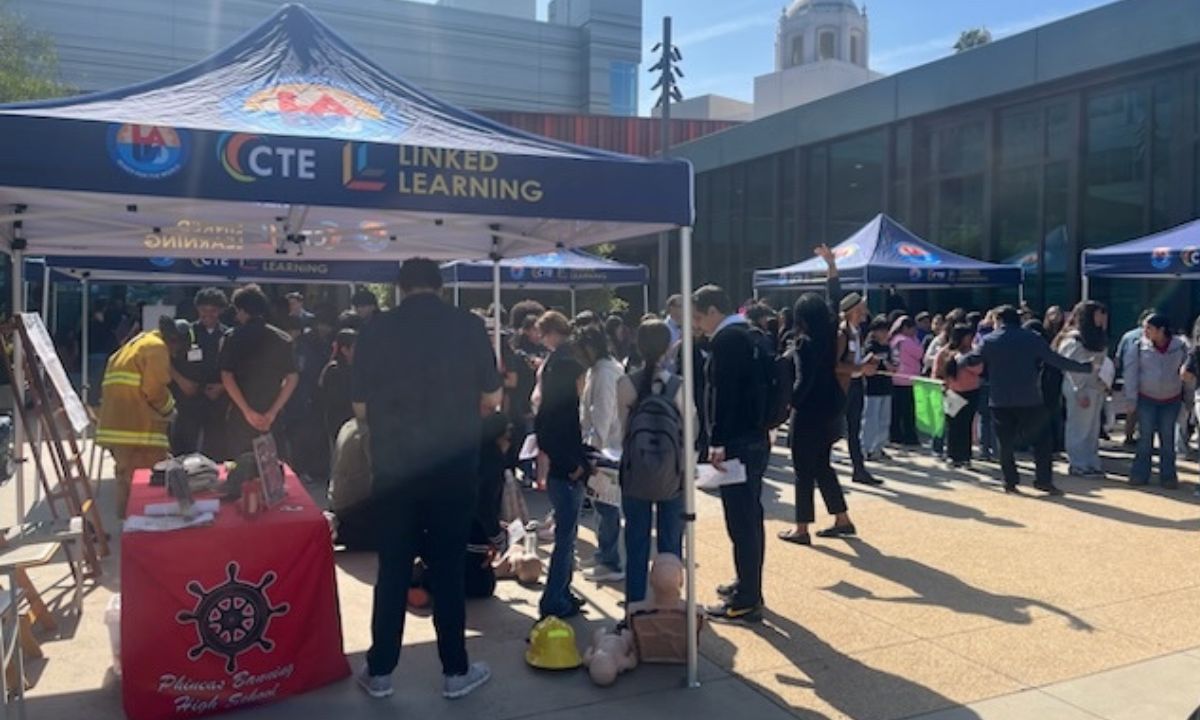‘I’m Capable of Doing … This’: L.A. Students Career and Tech Success
LA Unified’s Career Technical Education Department is growing, both in student participation and programs offered.

Get stories like this delivered straight to your inbox. Sign up for The 74 Newsletter
These days, success in today’s job market doesn’t necessarily mean going to college.
With the nation’s second largest school district now offering nearly 450 Career and Technical Education programs across 160 schools, Los Angeles Unified students are embracing CTE.
More than 47,000 students have access to programs that range from internships and dual enrollment courses to clubs, electives and required classes aligned with core academic subjects.
Earlier this month, hundreds of high schoolers demonstrated new skills at the California Endowment Center, from horticulture to computer programming, while middle school students toured booths and explored the programs they could soon join.
“I want to go into landscaping, designing people’s yards,” said senior Serenity Flores, who takes a horticulture class at Sylmar Charter High School. “And this class kind of brought me around to that.”
District data shows these offerings are growing fast. The number of paid student interns more than doubled, rising from just over 700 in 2023–24 to more than 1,600 this school year.
Industry certifications have also grown in popularity. Students earned more than 6,000 credentials in 2023-24, a 60% increase from the previous year, in areas like Microsoft Office, food handling and CPR.
One reason for the increase is the rise of Linked Learning, a California-based program that blends academics with career exploration and college credit.
The Linked Learning initiative began in 2009 as a pilot in nine school districts. Today, it’s grown to more than 50 districts. In LAUSD, over 21,000 students participated during the 2023–24 school year.
Romero’s school, Hilda Solis High School in Boyle Heights, is one of many that offers a Linked Learning pathway.
“I really enjoy it because it shows that I’m capable of doing things like this,” said Ivan Romero, who is enrolled in the school’s engineering design class.
To meet rising demand, the district announced a two-year pilot program in 2024 to trai new CTE teachers. LAUSD officials said the move was to address the growing need for skilled educators in CTE programs.
The pilot will support 25 new CTE teachers per year and pair each with a mentor.
According to a U.S. Department of Education study, students who took two or more CTE courses had a 94% graduation rate, compared to 86% for those who didn’t. Employers are also on board, with 96% viewing CTE applicants favorably.
Many of these students are graduating high school with certifications or finished college courses.
“Basically, when they graduate, they can start working,” said an LAUSD spokesman. “The emphasis on it is, when they get out of college, they’re ready to go to work.”
Although most students said the courses help build on their college plans or inform them of higher education choices, some have chosen blue-collar and trade programs as an alternative.
Sergio Garcia, a senior at Banning High School, gets to learn how to put out fires and do CPR from the Los Angeles Fire Department. Other students said they had never thought of becoming a firefighter before being introduced to the course. Now they can expect to have certifications and be working for fire departments straight out of high school.
Some educators say all students, not just the ones in blue-collar programs, should have that opportunity. Darryl Sher, who teaches the robotics club at LACES Magnet School, said students are often told college is the only route. CTE programs show otherwise.
“Most of them are going to college, but they could get jobs in tech right out of high school,” Sher said.
Even if the majority of students plan to go to college, or need a degree to pursue their ultimate career goals, there are plenty of programs to help students earn money right out of high school.
“Some have automotive programs, some have food safety courses,” Frank said, highlighting auto repair and customer service jobs as starting industries for many students. “They can get a job and do something that can support their college education.”
This article was published with the support of XQ Institute and is part of a collaboration between The 74 and the USC Annenberg School for Communication and Journalism.
Get stories like these delivered straight to your inbox. Sign up for The 74 Newsletter

;)